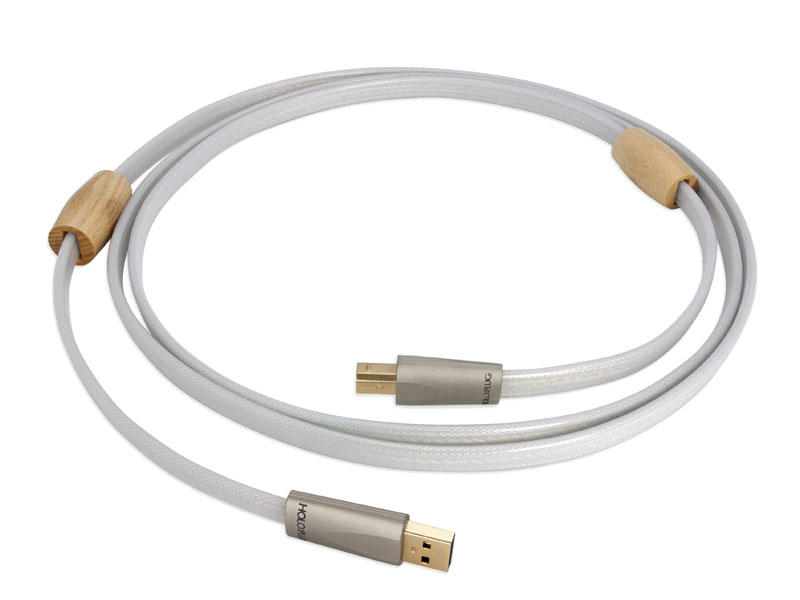The Necessary Link: Nordost's Valhalla 2 USB Cable
Companies other than Nordost, that is. As I reported, Nordost has chosen to take a particularly difficult path, manufacturing its HDMI cables in-house, and the same is true for its USB cables. Just look inside an HDMI connector and you’ll have some understanding of the difficulty: there are multiple closely spaced connectors, each of which has its own particular role. In addition, while there are five different HDMI-compatible connectors and three cable standards, USB possesses this kind of complexity and then some. There are even more connection options, and along with data-carrying duties, there is the need to provide DC power as well. A USB cable is often dismissed as merely “a computer cable.” However, it is easily one of the most complicated and difficult cables to design and manufacture, and audiophile use only makes matters worse. Nordost's Valhalla 2 USB cable ($3499.99) introduces a flat, twin-axial geometry to Nordost’s cable lineup. The significance of this is that the conductors are able to run in parallel -- important for a USB cable, which carries both signal and power -- instead of the standard twisted-pair geometry, increasing transmission speeds, which are vital for the USB 2.0 standard the Valhalla 2 achieves. The cable is constructed of four 19AWG solid-core, silver-plated conductors, each utilizing Nordost’s Dual Mono-Filament technology, which increases damping and maintains uniform spacing. The signal-carrying conductors are further isolated from those carrying power by a fine silver shield on the latter. Furthermore, all of the conductors are separately shielded, the shield connected to a metal-plated backshell to protect the cable of EMI and RFI. Each Valhalla 2 USB cable is terminated with Nordost's proprietary Holo:Plug fully shielded, low-mass connectors. Currently, Valhalla 2 cables are limited in terms of connectors to Type A and Type B. With this Nordost gives a nod to the broad part of the USB-cable market as well as its own ability to produce the cables in-house. Have you seen how tiny some of the other USB connectors are? Nordost would have to hire jewelers to terminate Valhalla 2 with these, if it would even be possible. I began listening to a single Valhalla 2 USB with just the type of digital system it would partner with in the real world: the dCS Vivaldi 2.0 stack. For my review of Vivaldi 2.0, John Quick, manager of dCS Americas, provided me with a spate of music on his personal NAS and USB drives, but I used the Valhalla 2 USB with my own Western Digital hard drive, replacing a generic USB cable. While non-audiophiles will discredit the efficacy of a USB cable, which “only carries data,” we careful listeners know that what the mass market misses has no bearing on what we actually hear from our systems. If the Valhalla 2 USB cable makes an appreciable improvement in sound, it has its place in the market. Sonic realism is what we audiophiles chase with each purchase. With the Valhalla 2 USB, as with the full loom of Valhalla 2 cables, “appreciable” is a vast understatement. In so many ways, what I heard from the Valhalla 2 USB mirrors my reaction to hearing Nordost Odin cables -- in the form of a single phono cable -- for the first time: the sense that I was not just hearing more of the music -- the finest details and the largest master strokes, all expertly integrated into the soundscape -- but less of a fine background scrim that I only noticed it once it was gone. Valhalla 2 was an absolute champ at revealing dynamic contrasts; like a better camera, it presented more shades of gray and redefined the relationship of light to dark in the process. And as with the very expensive Odin 2 interconnects and speaker cables, the Valhalla 2 USB seemed to elevate any equipment with which it was used. After my time with the dCS Vivaldi 2.0 system was sadly up, I used the Valhalla 2 USB cable with my Toshiba Windows laptop, tethered to Ayre's DX-5 DSD universal audio player and DAC. Again the cable made its presence known in the form of a quieter, more resolved and more vivid presentation. With all that I've written in the last two paragraphs in mind, I have to admit that I'm not a blind fan of file playback; the dCS and Ayre digital gear also sounded great spinning discs, and that's generally the way in which I used them, day in and day out. This mitigates the need for a USB cable, especially an expensive one like the Valhalla 2. But with the Valhalla 2, the efficacy of file playback was undeniable. It also brought to light the sonic pressure of the cable loom: the fact that when you're using a full set of Valhalla 2 or Odin 2 cables, you not only want, but need to keep the chain unbroken, the cumulative effect of using the same cable from wall outlet to speaker being of great sonic consequence. Given this, the only choice is the Valhalla 2 USB, not only because Nordost doesn't make an Odin 2 USB (yet) but also because it's the only way to extract and/or preserve all of the musical information that any given file can offer. Still, the Valhalla 2 USB won't be for everyone: it's
expensive and can only be terminated with Type A or B connectors. For these reasons, it
has a chasm to cross with some of the market. But if you've gone to the lengths necessary
to own top-of-the-line dCS, Wadax, Esoteric or MSB digital gear, the kind that brings into
question analog's eternal sonic superiority, the Valhalla 2 USB is a step on the same
path. |

